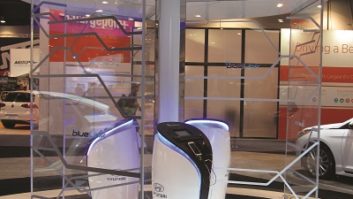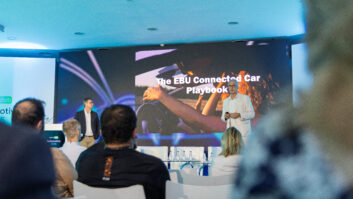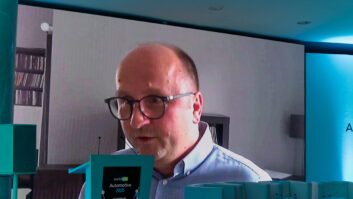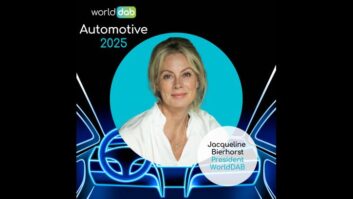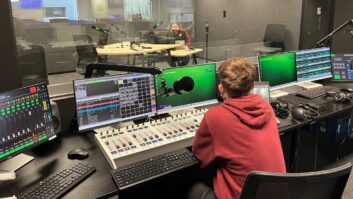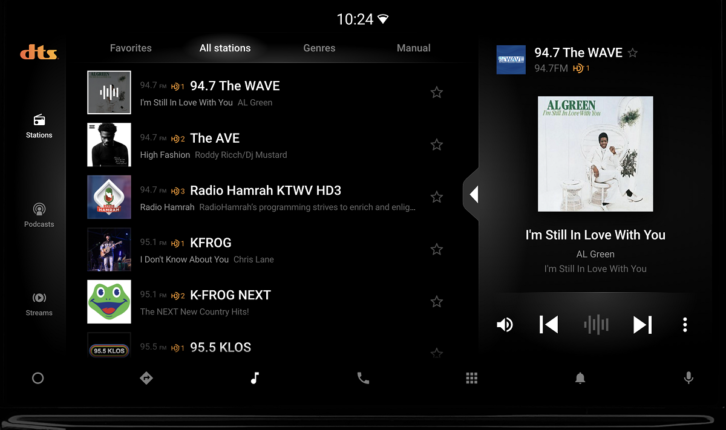
NAB PILOT, Xperi AutoStage and several U.S. and international radio broadcast organizations are taking steps to make sure radio is appropriately represented as automobile OEMs expand their use of Android Automotive.
The context: Big tech companies have been collaborating with carmakers in developing media environments of the future; those decisions will carry crucial implications for broadcast radio.
Broadcasters worry that some of the adaptations may not be in their best interests, especially since companies like Google and Apple seem well positioned to help choose software interfaces that will end up in the dash. Fast-developing innovation is adding urgency to those developments.
Radio in the conversation
Google’s Android Automotive OS is an Android-based infotainment system that is being built into some new vehicles and is gaining adoption momentum among car manufacturers.
The media system, which replaces the standard radio in the dash of most vehicles, is a standalone Android device with user apps installed directly to the car’s system — no smartphone required. (“Android Automotive” is distinct from “Android Auto,” where the system runs on the user’s phone.)
General Motors, Ford, Audi and Stellantis have announced plans to integrate the Android Automotive platform to power their infotainment systems in new cars. ABI Research said it expects 36 million vehicles will ship with Android Automotive in 2030.
It is against that background that NAB, Xperi and broadcasters like iHeartMedia and the BBC are working together.
A key aim is to coordinate the industry’s presentation of metadata for content and advertising.
John Clark, executive director of NAB PILOT, said the goal of the Android Automotive initiative is to make sure broadcast radio is properly supported in the open source system and help broadcast benefit from its rollout.
“Anytime you are talking about ‘what controls the radio and the dashboard,’ it’s important radio is in that conversation. We need to make sure radio functionality is built in and get Android Automotive to support it, and to make sure the tuner and all the broadcast standards like HD Radio, DAB and regular AM and FM are baked in and available to app developers,” he said. “The majority of automakers have already committed to Android Automotive.”
NAB PILOT, which is the association’s technology development initiative, is attempting to build a support system into the open source platform of Android Automotive.
“(Android Automotive) is open to anyone. If you develop in Android and Android Automotive, there is access if we are successful,” Clark said.
The initiative is intended to result in additional software and functionality in the Android Open Source Project (AOSP), with open source solutions available to Tier One and app developers around the world.
It’s important because there are “no guarantees the digitalization of the dash will be good” for broadcast radio, Clark said; it could lead to increased competition in the dashboard from pure-play services like Spotify.
“Further fragmentation, and broadcasters and auto manufacturers all doing things a bit differently with no one on the same page, is the worst-case scenario. That would mean different user experiences,” he said.
“We want the broadcast radio to be uniform from car to truck. When you take away the simplicity of radio and put it into a software user interface, it could turn into a giant challenge if people can’t easily find the product,” he said. “There is a huge benefit for cohesiveness.”
Clark said the group’s intent is to make sure “none of the features of broadcast radio are lost. And further, what happens if the dashboard becomes completely reliant on an IP connection? That would be disastrous if dashboard designers are not paying attention to the broadcast component.”
Companies involved in PILOT’s Android Automotive initiative include Bauer Media, the BBC, Beasley Media Group, Commercial Radio Australia, Cox Media Group, Entercom, iHeartMedia, New York Public Radio, NPR, Salem Media Group, SWR and TBS Radio. Clark said they are “providing their expertise and their voice” to the initiative.
Google is “listening”
Xperi is doing lot of the development work on dashboard redesign when it comes to delivery and rendering of metadata, said Joe D’Angelo, its senior vice president radio.
Xperi is the parent of HD Radio; it also recently launched the DTS AutoStage hybrid radio platform. It is a member of PILOT and describes itself as an advocate on behalf of the radio industry.
D’Angelo said Android Automotive “will control the radio tuner, so it’s imperative that broadcasters around the world ensure that Android Automotive fully implements all of the radio standards that are commercially deployed in the world. It’s critical that the head units have the ability to tune in analog AM and FM, HD Radio and DAB signals. That is going to be dependent on the completeness of the operating system’s functionality,” he said.
“Google is engaged with our group, but they are a huge company that has a lot of competing constituents looking for support and resources, too.”
Google did not reply to Radio World’s requests for comment about Android Automotive and how radio fits into the evolving tech landscape.
Clark of NAB said Google is “listening to us like any good company should that wants to get feedback on their product. They have asked us to remain in talks with them. They are very much interested in our progress and they want to hear more from the players in the field, and how what we are doing aligns with what auto manufacturers are doing in the dash.”
He added: “We have to convey to Google that if they pay attention to radio, then radio will really be there with these services.”
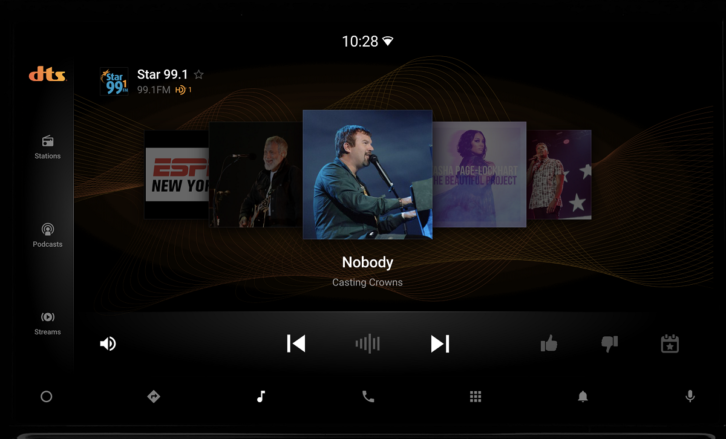
D’Angelo said NAB and Xperi have “open access to Google’s engineering and strategic partnership teams” and can “can educate them on our progress. … We have a long history of working with Google, the automakers and the Tier Ones so we bring to the table our product development, engineering and product certification expertise.”
While Android Automotive is a relatively new entrant to the dashboard wars, he said Google is quickly making inroads.
“I think what is unique is they are coming in not only with a new operating system but also with a suite of applications. It’s not dissimilar to what they did in the smartphone space. They are not dominant yet in auto, but they are trying to make a big push into auto.”
D’Angelo sees natural overlap between Android Automotive and DTS AutoStage, though he said the latter focuses on ensuring terrestrial radio’s presence in the dash.
Google is “offering a set of IP-based services alongside (the Android Automotive) operating system,” he continued, but Xperi is focused on the radio broadcast component.
“Android Automotive is a hybrid system. It has IP functionality, connectivity to the internet and support for over-the-air reception. So it is a platform that DTS AutoStage as a service can be integrated on, but it is not the main goal for the group. That part of it is attractive to us and other hybrid radio advocates, but the scope of the project is solely focused on getting broadcast right. Because if we don’t get broadcast right, there is no hybrid radio,” he continued.
“First we have to ensure that the automakers around the world adopting Android Automotive have the best analog and digital broadcast radio experience possible. Then we can talk about how we evolve and maybe take advantage of the IP connections.”
Broadcasters for now should remain diligent and support efforts to add metadata to their broadcast signals, NAB’s Clark said.
Broadcasters should make sure their over-the-air service “is taking advantage of all the functionality of the transport system,” D’Angelo said. “If radio is offering a rich, compelling multimedia experience that benefits the driver of a vehicle, then the car companies will be compelled to implement all the technology.”
He said companies supporting the PILOT project realize the importance of broadcast metadata being displayed on the dash alongside audio services, and that the metadata is actually presented to the driver, not replaced.
Michael Beach, VP of distribution at NPR, said, “NPR and PRSS believe it is critical to work with the National Association of Broadcasters and Xperi on the development of efforts like this, which will continue the vitality of broadcast radio and take advantage of features on new and emerging platforms.”
Broadcaster involvement, D’Angelo said, is “really critical so we can accelerate the deployment of these great services for vehicle manufacturers that have committed to Android Automotive. And we’re really pleased to have some of the largest broadcasters giving us feedback.”
